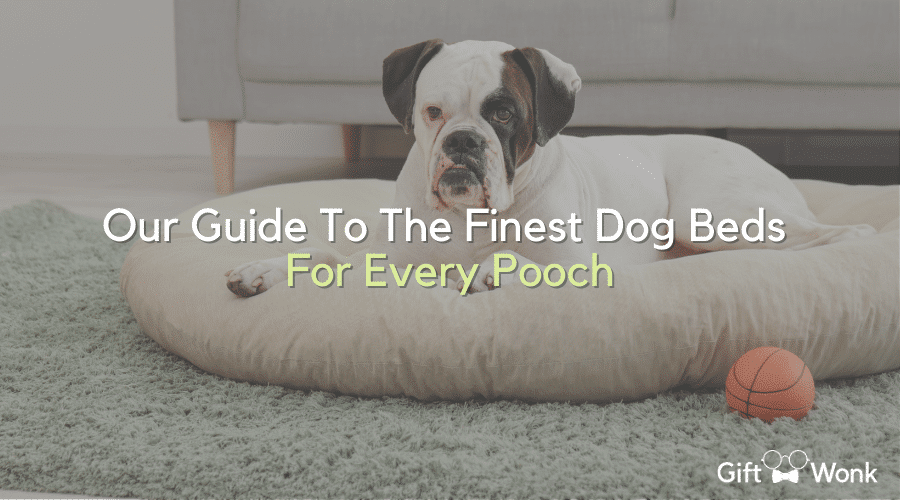
!! DISCLAIMER !! This site may contain Amazon & other affiliate links.
This means if you click on one of the product recommendation links, this site may receive a small commission. This is at no extra cost to you and may include exclusive discounts when possible. This helps support this site and allows us to keep making content like this. Thank you for your support!
Our Guide To The Finest Dog Beds For Every Pooch
The finest dog beds provide a comfy environment for your pet to sleep in. Furthermore, they should be long-lasting and functional and provide adequate space for your dog to stretch and rest after a long day.
With so many shapes and types of dog beds available, deciding which is best can be difficult. However, there is a bed for every size of the dog, from bulky dog mattresses to plush and cuddly donut-shaped beds.
So, if you’d rather your pet not sleep on your sofa or bed and have their own resting space, a lovely dog bed might be just the thing.
The elements to look for in a good dog bed aren’t too dissimilar to those you’d seek in the best mattress for yourself. For example, firmness, the material used to make the dog mattress, and how easy it is to clean.
Furthermore, if you have an elderly dog or a working dog, you may want to consider an orthopedic dog mattress for additional support.
Other characteristics to look for in the best dog beds include washable, antibacterial covers and non-slip bottoms to ensure that the bed does not move about too much when your dog is inside.
Meanwhile, we’ve compiled a fantastic list of the finest dog beds for every doggie, need, and price.
Factors To Consider When Selecting The Finest Dog Bed
- Take your dog’s measurements. To accommodate the many sleeping positions preferred by dogs, the dog bed should be slightly larger than your pet’s.
- Examine your dog’s sleeping habits. For example, if they spread out on the couch, a rectangular bed with room to ‘starfish’ could be best; however, if they like to turn in a circle a million times to make a cozy little nest, a cuddler or cave bed could be best.
- Examine the material of the bed. If your dog enjoys biting and chewing, you should look for sturdy bedding. Some even offer money-back guarantees if your dog ever destroys it.
- Take into account your dog’s age. As your dog ages, it will require a more supportive bed that does not put further strain on its joints. Check with your dog’s doctor to ensure that the bed you’re considering will meet your senior dog’s needs.
- Consider your level of comfort. Elevated designs can increase airflow, keeping your pet cool. An elevated choice is ideal if you use the dog bed outside because it will not become as dirty. However, for cold weather or indoors, a plush dog bed is more comfortable than an elevated one.
- Check to see if it’s washable. Check the packaging or care label to ensure that the dog bed or cover is machine washable, making cleaning easier.
What Is The Best Type Of Dog Bed?

Consider the size, fill, and shape of the perfect bed for your dog. A memory foam dog bed with bolsters or a wraparound shape is best for most dogs.
Examine your dog’s preferred sleeping positions to discover whether he prefers a platform, wraparound, or bolster bed. Measure him for the proper bed size, and then select the material and fill best suited to your companion.
Do Dogs Require Soft Beds?
Dogs do not require soft beds but rather a hard surface to rest on; too-soft beds do not provide the support required for good sleep and healthy joints, and an aged dog who sinks into a soft bed may have difficulty getting into and out of it.
This does not imply that they should sleep on the floor—that would be too hard for them. Provide them with a bed with memory foam or a chambered polyfill sleeping surface instead.
A memory foam bed adjusts to your dog’s body, relieving pressure, evenly distributing his weight, and providing tailored-to-him comfort.
Many dogs require orthopedic beds, and they aren’t just for the elderly: Memory foam provides exactly the appropriate amount of joint and muscle support for a lifetime of comfort, making it ideal for younger, growing dogs.
The Advantages of a Raised Dog Bed

A raised dog bed—one that is elevated with robust legs rather than flush with the floor—might be a nice option for your friend. A raised bed provides more airflow, keeping your dog cooler in the summer and warmer in the winter.
Climbing in and out of an elevated bed may be simpler for your senior dog, as rising from a floor-level bed might strain his joints.
If you prefer spending time in the yard or camping with your dog, some raised dog beds can be wiped or hosed down, making cleanup easier. Your dog will sleep soundly if you cover it with a dog blanket.
Older Dogs Require Additional Joint Support
According to the American Academy of Veterinary Medicine, orthopedic dog beds are beneficial for elderly dogs. This is because no amount of blanket piling can offer the joint support these dogs require.
However, climbing onto and off of couches, chairs, and beds can also be dangerous for dogs with mobility impairments unless dog stairs are provided.
Orthopedic beds are ideal for senior dogs suffering from arthritis and joint difficulties. These beds support your dog’s joints and pressure points, easing his transition from laying down to standing and aiding in managing his arthritic symptoms.
Most orthopedic mattresses are made of a specific foam that ‘gives’ just enough to adjust to the contour of your dog and recovers after each use.
Dog Beds Benefit Dog Health

An orthopedic dog bed will benefit dogs of any age that have joint difficulties, hip dysplasia, or are recovering from surgery or broken bones. And any type of dog bed will help avoid sores and chafing that can arise when dogs spend long periods on a hard surface.
Finally, dog beds create a sense of stability that benefits all dogs, especially anxious dogs. His bed is a small piece of home you can take with you when you travel or relocate to reduce worry, and it can be your dog’s particular location when he’s left alone.
Dog Beds Improve Human Sleep
According to a recent Mayo Clinic sleep research, people who slept with a dog in their bed had a worse night’s sleep than those who did not sleep with a dog. Conversely, people who slept with their dog in their bedroom but not in their bed had a better night’s sleep.
The dog’s presence in the room appeared to provide individuals with a sense of security, but when the dog shared a bed, its movements disrupted human sleep. According to the study, having many dogs in the bedroom, in or out of their owner’s bed, can disrupt sleep.
Dog Beds Keep Fur at Bay
Dog beds reduce fur and dander in other areas of the house. Naturally, everywhere your dog goes, he’ll leave a trail of hair and dander behind him. When he has a dog bed, however, most of it collects in one location, making cleanup simple.
In addition, your dog’s bed comes with a cover that you can quickly remove and wash when it needs a thorough cleaning. Many pet parents purchase backup dog bed covers so that they can rotate when one is washed.
You lie down on your rug from time to time to watch TV or play and snuggle with your closest friend. It’s fine for short periods, but if it were your only option for sleeping and resting, you’d be uncomfortable, cranky, and painful.
Giving your dog his bed guarantees that the four-legged part of your family, too, feels the safety, comfort, and warmth of home.
Top 5 Dog Beds For Furry Friends
[wptb id="8971" not found ]Final Thoughts
Consider how wonderful your dog would feel after a long, restful night’s sleep on their dog bed. These dog mattresses can help your pup achieve the same restful slumber. Furthermore, your dog will no longer want to sleep in your bed or on the couch.
Frequently Asked Questions
Is it better for dogs to sleep on hard or soft beds?
Dogs don’t require soft beds but rather a firm surface to rest on; too-soft beds do not provide the support required for good sleep and healthy joints, and an older dog who sinks into a plush bed may have difficulty getting into and out of it.
This does not imply that he should sleep on the floor—that would be too firm.
What kind of material do dogs prefer to sleep on?
Gel-cooled beds come in a variety of shapes and sizes. They can be used in thin mattresses or as an additional layer in heavier memory foam beds.
This item is designed to keep your pooch cool while sleeping and prevent them from overheating. This is an excellent choice for dogs with thick coats or those who live in warm areas.
How many beds do dogs require?
Your dog requires at least one bed to call his own. Keep him comfortable no matter where he wants to sleep by providing him with numerous dog beds throughout the house.
If you travel frequently or have a camp or cabin, you may want to purchase more dog beds for different areas. Instead of moving a single dog bed throughout the day, utilize different dog beds to provide your buddy options so he can have a nice seat in his usual hangouts.
Provide supportive areas wherever he likes to relax, such as the living room, kitchen, porch, and the floor alongside your bed. On the other hand, he undoubtedly wants to keep an eye on you, so put a bed in areas he frequents to make them his.
Don’t forget that your dog needs a crate bed: When you have to leave your dog behind, a dog bed provides greater support than the cold, hard floor of his crate.
Begin training your puppy to sleep in his dog bed or crate as soon as he is old enough so he develops a sense of his own ‘home’ as soon as possible.
Then, when you’re confident that your puppy (or adult dog) can spend an extended period in his crate without destroying his bedding or toys, it’s time to upgrade to a dog bed. Memory foam or lofty, cushioned fiberfill bed provides extra support for your dog while he waits for you to return.
A bolster-style bed allows him to recline against the crate without pressing into its wire sides, provides a place to lay his chin, and provides some protection for the dog that loves to sleep curled up.
This also applies to the car. For your dog’s comfort and security on road trips, keep a robust indoor/outdoor bed in his travel crate or the rear of the car.






